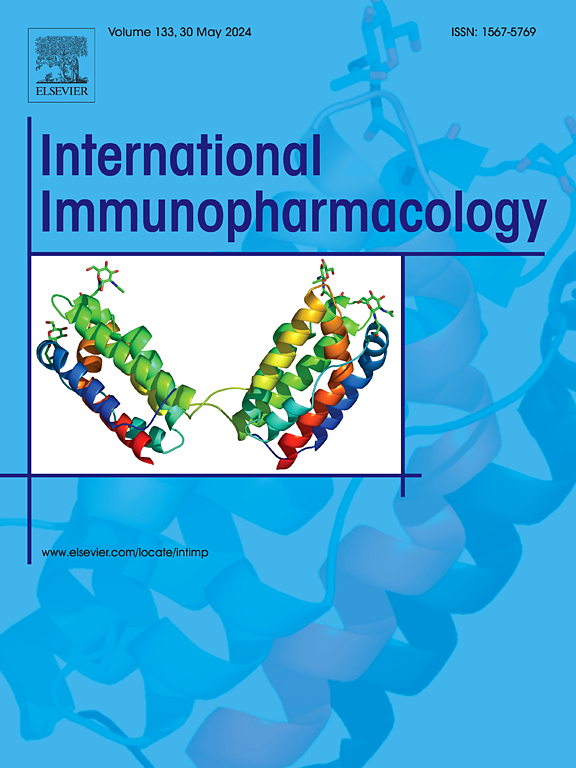Propionate alleviated colitis by modulating iron homeostasis to inhibit ferroptosis and macrophage polarization
IF 4.7
2区 医学
Q2 IMMUNOLOGY
引用次数: 0
Abstract
Ulcerative colitis (UC) is a relapsing inflammatory bowel disease with limited effective treatment options. Ferroptosis, characterized by lipid peroxidation-induced cellular death, is involved in UC pathogenesis. Propionic acid, a short-chain fatty acid, has demonstrated therapeutic potential in alleviating numerous conditions; however, its role and underlying mechanisms in UC remain unclear. In this study, we analyzed ferroptosis in UC patients using datasets from the GEO database and established an experimental colitis model to evaluate the therapeutic effects of propionate. We assessed the markers of inflammation and ferroptosis. Our findings revealed that ferroptosis occurred in the colonic tissue of UC patients and mouse colitis model. Propionate effectively alleviated UC symptoms, reduced pro-inflammatory cytokines, and regulated iron homeostasis. At a dose of 100 mM, propionate promoted intestinal epithelial regeneration, while 400 mM inhibited ferroptosis significantly. Mechanistic studies demonstrated that propionate increased the expression of transferrin receptor 1 (TFR1) and ferritin heavy chain 1 (FTH1) in a dose-dependent manner, which was associated with reduced hypoxia-inducible factor 1α (HIF-1α) expression. Moreover, after inhibition of HIF-1α, the therapeutic effects of propionate on colonic symptoms were found to be similar. Furthermore, propionate promoted the polarization of macrophages to the M2 type. Our results indicate that propionate regulates HIF-mediated expression of TFR1 and FTH1 to modulate iron homeostasis, promote epithelial regeneration, inhibit ferroptosis, and regulate macrophage differentiation. These results strongly support the potential use of propionate in the clinical treatment of UC.

丙酸盐通过调节铁稳态抑制铁下垂和巨噬细胞极化减轻结肠炎
溃疡性结肠炎(UC)是一种复发性炎症性肠病,有效治疗方案有限。以脂质过氧化诱导的细胞死亡为特征的铁下垂与UC的发病机制有关。丙酸是一种短链脂肪酸,在缓解多种疾病方面具有治疗潜力;然而,其在UC中的作用和潜在机制尚不清楚。在这项研究中,我们使用GEO数据库的数据集分析UC患者的铁下垂,并建立了一个实验性结肠炎模型来评估丙酸盐的治疗效果。我们评估了炎症和铁下垂的标志物。我们的研究结果显示,UC患者和小鼠结肠炎模型的结肠组织发生铁下垂。丙酸可有效缓解UC症状,降低促炎细胞因子,调节铁稳态。在剂量为100 mM时,丙酸盐促进肠上皮细胞再生,而400 mM时显著抑制铁下垂。机制研究表明丙酸增加转铁蛋白受体1 (TFR1)和铁蛋白重链1 (FTH1)的表达呈剂量依赖性,并与缺氧诱导因子1α (HIF-1α)表达降低有关。此外,在抑制HIF-1α后,发现丙酸盐对结肠症状的治疗效果相似。丙酸促进巨噬细胞向M2型极化。我们的研究结果表明,丙酸调节hif介导的TFR1和FTH1的表达,以调节铁稳态,促进上皮再生,抑制铁凋亡,调节巨噬细胞分化。这些结果有力地支持丙酸盐在UC临床治疗中的潜在应用。
本文章由计算机程序翻译,如有差异,请以英文原文为准。
求助全文
约1分钟内获得全文
求助全文
来源期刊
CiteScore
8.40
自引率
3.60%
发文量
935
审稿时长
53 days
期刊介绍:
International Immunopharmacology is the primary vehicle for the publication of original research papers pertinent to the overlapping areas of immunology, pharmacology, cytokine biology, immunotherapy, immunopathology and immunotoxicology. Review articles that encompass these subjects are also welcome.
The subject material appropriate for submission includes:
• Clinical studies employing immunotherapy of any type including the use of: bacterial and chemical agents; thymic hormones, interferon, lymphokines, etc., in transplantation and diseases such as cancer, immunodeficiency, chronic infection and allergic, inflammatory or autoimmune disorders.
• Studies on the mechanisms of action of these agents for specific parameters of immune competence as well as the overall clinical state.
• Pre-clinical animal studies and in vitro studies on mechanisms of action with immunopotentiators, immunomodulators, immunoadjuvants and other pharmacological agents active on cells participating in immune or allergic responses.
• Pharmacological compounds, microbial products and toxicological agents that affect the lymphoid system, and their mechanisms of action.
• Agents that activate genes or modify transcription and translation within the immune response.
• Substances activated, generated, or released through immunologic or related pathways that are pharmacologically active.
• Production, function and regulation of cytokines and their receptors.
• Classical pharmacological studies on the effects of chemokines and bioactive factors released during immunological reactions.

 求助内容:
求助内容: 应助结果提醒方式:
应助结果提醒方式:


